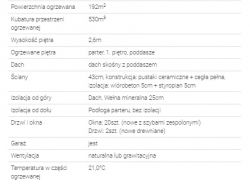Good day. I am not a professional, nor do I professionally deal with heating or building systems. However, I love modern technologies used in the construction industry. So today you can have a very large HOUSE and incur operating costs as if too small

So I will try to help, although I also need the support of a PROFESSIONAL

(When I was a young boy, I bought my first FIAT 126p car. It burned 6 liters of petrol with a capacity of 594 cm3 and at the same time my older friend bought a Passat 1.9 TDI, which burned 4.5 liters of diesel fuel and then diesel fuel was 2x cheaper than petrol: that's when I became inspired by technical innovations).

Immergas Victrix Exa is a modern drive unit with a maximum usable thermal efficiency of 107.8%: it has a modulated burner, an electronically modulated circulation pump and uses the phenomenon of condensation and WE must be able to take full advantage of it

Let's treat it as an experiment that can bring radical benefits

When the service technician connected the stove to me, he showed me how to change the service settings to adapt the boiler to my installation

Another service technician also showed my cousin how to change the parameters of the boiler, but he has a 700 m2 HOUSE (guest house) and another Junkers Cerapur Comfort 28 kW stove, but you can follow him

The manual shows that our stove works most effectively when the supply temperature is 40°C and the return temperature is 30°C at 30% load. Under no circumstances must the outlet temperature exceed 50°C for the furnace to condense. Settings: point 3.8 electronic card programming page 28 of the manual. I suggest :
1. Temp. of water in the boiler 45°C is already hot, so we will also set the CO at the beginning. 2. Minimum power wu S0=900. 3.S1=3500. 4.S2=900. 5.S3=900. 6.S4 ignition power bz=2000. 7.S5=20. 8.S6=45 but ultimately we will decrease this parameter. 9.S7=0.bz 10.S8=0 and we need to change the parameter PO=1. (here we will look for the optimal setting). rest bz. Next, let's move on to the parameter t0=4 (here we will mainly look for very good settings). t1=84.
When you are ready, Mr. Mariusz, please let me know: I will help

PS.1. Before installing a new boiler/stove, it is mandatory to rinse the radiators, because they collect sludge, dirt, rust, etc. or to install new ones: especially when switching from an open to a closed installation

PS2. Nowadays, in new houses and for new installations, suitable liquids are used instead of water. They have inhibitors, anti-foams, anti-corrosion agents and better heat transfer

PS.3. In general, these stoves are intended for very large houses or houses where there is a large inertia, i.e. a lot of fluid - the factor in the system, i.e. like mine, because I have floor and master, because thick pipes and large radiators. In such houses, you cannot afford to cool down the liquid in the system, because the costs of reheating will be huge, and these are the most common causes of rapid gas consumption. With these settings, gas consumption can be reduced by at least 1/3. In addition, under no circumstances should it exceed 15m3/day if it works non-stop, i.e. max 450m3/month. Ultimately, with a very good setting of the stove, we should go below 10m3/day, i.e. about 300m3 per month.
Regards AG from Świnoujście.





